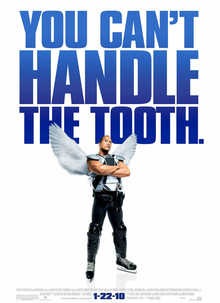 |
| Yes, I watch absolutely terrible movies. |
Humans are born with 20 baby teeth.2 Since you live about 80 years, your rate of tooth loss is about
(20 teeth per person) / (80 years)
= 0.25 teeth / year · person.
= 0.25 teeth / year · person.
Not all of the world believes in the Tooth Fairy, so it's a safe bet that she doesn't visit every newly gap-toothed child. Assuming only 10% of the world (roughly 700 million people) have been visited by the Tooth Fairy, then the total number of teeth that have been collected this year would be
(10%) · (1 year) · (700 million people) · (0.25 teeth / year · person) = 1.8×107
That's 18 million teeth, or roughly enough teeth to fill a refrigerator. Apparently, our cartoon Tooth Fairy is fairly accurate.
[1] In case you're wondering, most of my inspiration for estimations comes from watching cartoons.
[2] I'm not including wisdom teeth in this calculation since (a) the Tooth Fairy generally doesn't collect these, and (b) when removed, they're considered biological waste, so the dentist doesn't give them to you. As if having surgery isn't bad enough, they don't even let you keep them a souvenir, which, incidentally, belonged to you in the first place. I only discovered this after having shoulder surgery where the doctors removed some small bone fragments. I was particularly upset that I couldn't keep the bone chunks, because I figured the Shoulder Fairy probably paid a lot more than the Tooth Fairy. Alas, it wasn't to be. My mom tried to convince me that it wouldn't have mattered anyway because there's no such thing as a Shoulder Fairy, but I think she was just trying to cheer me up.

Arguably baby teeth are lost over a much shorter period of time than 80 years; say 15 at most by which time the tooth fairy effect has been reduced to zero.
ReplyDeleteHence more teeth are available per annum than your estimate.
Also you have not considered the deflationary economic impact of the cash put under pillows - if i were a world leader in these troubled times I'd be keen to suck up to the fairies and establish a fair rate of return so that as much cash were taken up into children's savings as possible.
Perhaps I'm misunderstanding, but I'm not sure that baby teeth being lost over a shorter time period changes the result. Since you're sampling from the entire population, which includes everyone from babies to octogenarians, you have to take into account the fact that anyone in their teens or older won't be losing any baby teeth.
ReplyDeleteOne thing that will increase the result is the fact that the world population is skewed (i.e. there are more young people than old people.) As such, there are more people in the age range that lose baby teeth than you would expect from a uniform distribution of ages, which is what I assumed. This will certainly increase the result, but I doubt it will change it by an order of magnitude. Thanks for the comment...it helps keep me honest.
Oh...and yes, I forgot about the economic impact. There's actually a cute bit about this at the end of the Wikipedia entry for "Tooth Fairy".
Haha. A shoulder fairy? The tooth fairy is a fairly common figure, but a shoulder fairy is definitely new. Awesome! When I was a kid, I was always excited after losing a tooth because I believed the tooth fairy would get it in exchange for money! Hehe. =)
ReplyDeleteFred Collinsworth